August 16-29, 2024
Note: This post has wayyy too many photos so the Substack app may not be able to open it. (A first for me!) For now the solution is to open at it on a web browser instead.
Dear friend,
I live in the French Alps, but until this month, I had never really seen the Swiss Alps. The Alps form an essentially continuous arc of severely crumpled earth over half a dozen countries1, and country borders are more arbitrary than not. At the same time, topography plays a role in border drawing, and the Alps have distinctive geo-ecological and cultural zones with their own ancient histories. Switzerland can claim the “heart” of the Alps and almost all the highest peaks—notably excluding Mont Blanc2, which is split between France and Italy—and many of the most iconic.
My parents (major Europhiles perpetually torn about whether they want me to keep living in Europe or move closer to them in the U.S.) planned this trip and took me along. We drove a loop through Lausanne, Bern, Interlaken, Lucerne, Zermatt, Chamonix-Mont-Blanc, and (after dropping me off in Grenoble) to Geneva. I could write multiple, multiple posts about every single one of those places, but since I was keeping my Detail Diary along the way, you’re about to get a small sampling of all of them.
I will say: it was stunning. Every day layered on more natural and cultural wonders of color, texture, and magnificence, and my brain could barely keep up. Even this Disneyland-esque whistlestop tour, however, was enough to start triangulating mountains and cities that had only been concepts before. I regularly pulled up Google Earth and spun the three-dimensional map in circles around my dot to render the surrounding peaks and passes more effectively in my brain. Now, when I read Romantic poets on Mont Blanc and Victorian accounts of Alpine ascents and see paintings of the Grindelwald Glacier, I can place all of them in my own catalogue of specific wonder. Now I know personally where the Rhone river originiates, and what it’s like to touch the slick, ghost-threaded inward ice of a glacier, and what an alpenhorn chorus sounds like echoing over Lake Lucerne. (And what it’s like to descend 1500 meters in 10 minutes in a cable car while severely congested. You will feel like you’re bleeding out of your eyes. But seeing Mont Blanc from the Aiguille du Midi is worth it.)
This is why I travel.
Here is your usual reminder that this post is best viewed on the web or in the Substack app. (From email, click on the title of the post or “Read in app.”) Clicking on a Note will also take you to the browser/app to see its full text and additional photos. This time there are MANY photos. The square cropping also does some of them dirty, another reason to take a closer look.
For an introduction to my Detail Diary, see here, or peruse past volumes.
Day 0: Divonne-les-Bains
Just a post-flight transit night: Sweet babbling of brook and bougie spas made for a tantalizing pass-through…
Day 1: Lausanne
A city I’ve visited and loved before, now showing my parents the sun-soaked vineyards and cathedral views. Trailing our feet in Lac Leman at Rivaz.


Day 2: Bern
For some reason the charm of Bern was a revelation. I didn’t really think of this, one of Europe’s smallest capitals, as a destination. But it is—a perfect dose of lush gardens, medieval rooftops, bridges spanning the Aare, quirky shops and markets. It was free museum day and we visited four (including Einstein’s house). We also discovered Elfenau, an idyllic estate in the embassy district where we listened to a Baroque ensemble through the window of the ivy-draped orangerie.
Still skirting the true Alps: between the Jura and the Berner Oberland.
Day 3: Transit to Interlaken via Thun
I still can’t read “Thun” without thinking of tuna, but this is actually an Insta-perfect medieval town on the Thunersee, one of the lakes bookending Interlaken. We visited the castle, learned about the history of Bernese conquests and spoils of war, and then admired the castle and its whitewashed companion chapel from the Rathausplatz below.
We had entered the Berner Oberland. Clouds hid the mountains above the Thunersee.
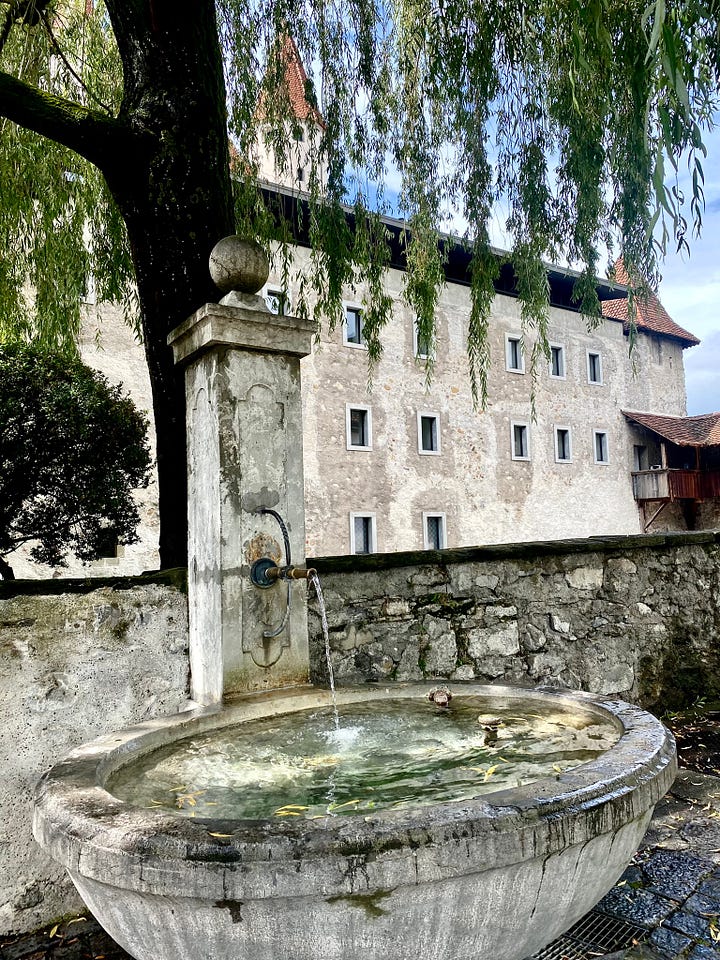
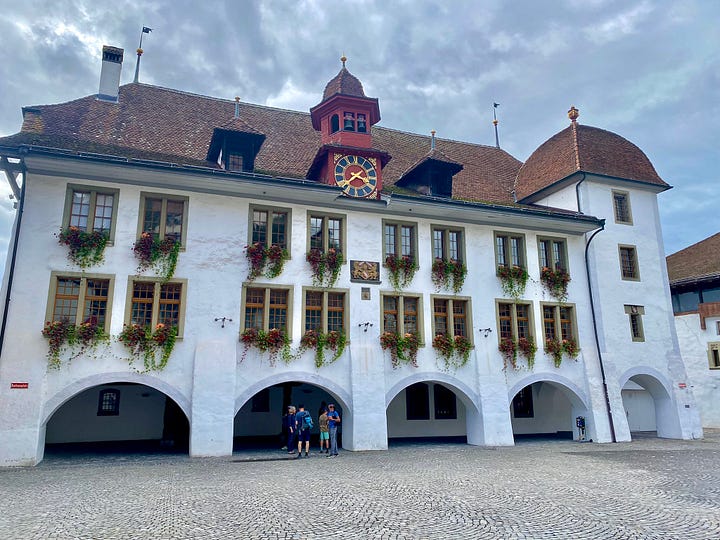


Days 4-6: Jungfrau region
Lauterbrunnen and Grindelwald valleys, above Interlaken
Leslie Stephen, before he fathered Virginia Woolf, was an eminent climber in the golden age of alpinism. He wrote a book about his exploits called The Playground of Europe. Here is his opinion of this part of the Alps3:
…neither Chamouni nor Zermatt, in my opinion, is equal in grandeur and originality of design to the Bernese Oberland. No earthly object that I have seen approaches in grandeur to the stupendous mountain wall whose battlements overhang in mid-air the villages of Lauterbrunnen and Grindelwald; the lower hills that rise beneath it, like the long Atlantic rollers beaten back from the granite cliffs on our western coast, are a most effective contrast to its stern magnificence; in the whole Alps there is no ice-stream to be compared to the noble Aletsch glacier, sweeping in one majestic curve from the crest of the ridge down to the forests of the Rhone valley; no mountains, not even the aiguilles of Mont Blanc, or the Matterhorn itself, can show a more graceful outline than the Eiger…
This was our first foray into the Alps proper on this trip, and we were dazzled (not only by the ticket price of the Jungfrau Travel Pass4). We agreed that although our later stops at the Matterhorn and Mont Blanc only turned up the impact dial, the Jungfrau region in all its variety and design was the most like a fairyland—literally Rivendell. It took us all three days, much bargaining with weather apps, many cable cars and cogwheel trains and a few hikes to start figuring out what we were looking at, those two right-angled valleys and the peaks “ whose very names stand alone in the Alps for poetical significance—the Maiden, the Monk, the Ogre, the Storm Pike…”—that is, the Jungfrau, the Mönch, the Eiger, the Wetterhorn. And more.
We were blessed with breaks in the mist like puzzle pieces and a day of passing blue sky. Everywhere, cow bells and the trilling of alpine choughs.5
The walk from Kleine Scheidegg to Männlichen
Grindelwald and Grindelwald-First
A Frau selling Alpekäse
The Eiger Trail and the cable car to Grindelwald-First
The Alpengarten at Schynige Platte
On the last day we visited Trümmelbachfalle in Lauterbrunnen on the recommendation of a local. It’s a glacier-melt chute—the combined melt of Eiger, Jungfrau, and Mönch—carving and thundering its way out through the mountain, with galleries and tunnels carved in the opposite direction by curious humans. Going inside that gorge was like standing inside a double helix or Fibonacci spiral.
Day 7-8: Lucerne + Furka pass
We returned to the edge of the Alps to see Lucerne, where Mount Pilatus regards the Alpine horizon. We didn’t go up that mountain, fearing redunancy, and instead absorbed sun and culture in the city. Highlights: a stunning Art Nouveau church near our BnB, the Rosengart Collection of Klee and Picasso, medieval bridges and towers along the Reuss, and Wagner’s idyllic house on Lake Lucerne where he spent the happiest few years of his life. We decided not to go to a full five-hour performance of Die Walküre.
Our journey back into the Alps took us over the vertiginous Furka pass (we narrowly avoided taking the GPS-suggested railway shuttle through a tunnel instead). This is where James Bond stalked Goldfinger and where the Rhone glacier has retreated hundreds of meters from the defunct Hotel Belvédère built to view it.

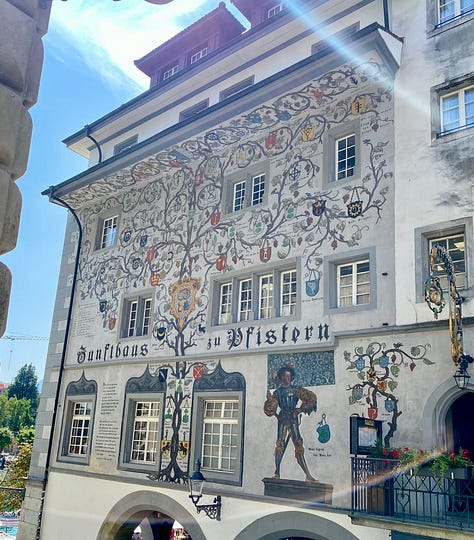


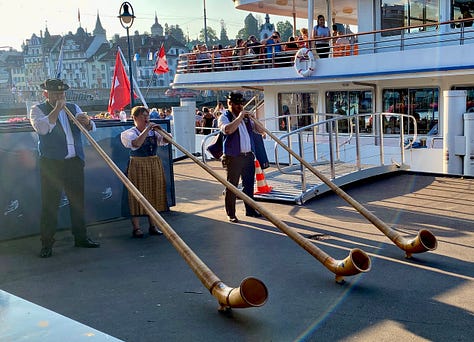


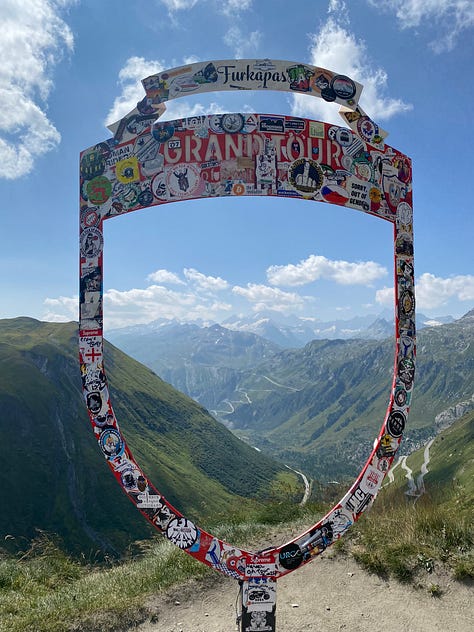
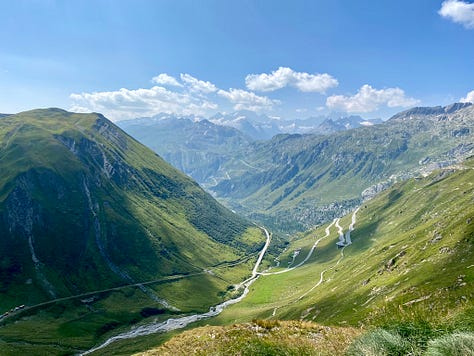
Day 9: Zermatt and the Matterhorn
The remainder of the trip is brought to you by DayQuil. I came down with a nasty cold, but I wasn’t about to stay home from the Matterhorn. It is truly an “unrivalled obelisk.” We took the Gornergrat6 train up and walked slowly down several stops, revelling in the windswept rockscape and its platonic-ideal pyramid of a peak, mantled by ever-rolling cloud and cottongrass. Eating lunch above its reflection while tiny frogs poked through the cottongrass. Dodging ultramarathon runners and admiring intrepid dogs.
In Zermatt, we lolled on the grass by the Catholic churchyard where climbers who didn’t survive their climbs over the last century or two are memorialized. Earlier, in the car, I read out loud Virginia Woolf’s germane story The Symbol. (More on that from Ronald Turnbull here.)



Day 10: Transit to Chamonix via Sion
On our next drive, we noticed some castles on a hill and took an exit to Sion at the last second. We spent the whole afternoon touring the 13th-century Chateau de Tourbillon, one-time seat of prince-bishops until sacked by nobles of Valais, and the stately nearby basilica that our guide emphatically reminded us is not a castle. The ancient chapel in the castle and the basilica were painted with vivid designs in secco—not fresco—plaster.
Closer to Chamonix, we made another spontaneous stop by an apparently Insta-famous pink chapel on the Forclaz Pass. Soon, we were in France.
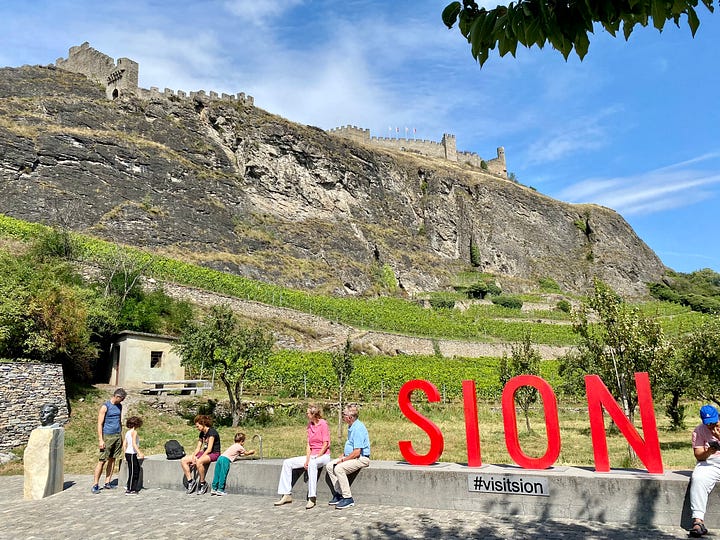

Day 11: Chamonix-Mont-Blanc
Taking the cable car up through the layer of cloud cloaking the valley to the top of the Aiguille du Midi was a quite literally a portal to another world. Everything was crag and ice and vertigo. Plus the precarious infrastructure that got us up there. The white shoulders of Mont Blanc shrugged immensely at us.
We took another cable car across the glacial fields to Punta Helbronner in Italy. Below us, people like black ants made their way along the ridges of ice. I felt like I had earned none of this.
From the 3470m observation point, we could have seen the Matterhorn—Cervino, it’s called—but there was a cloud.
Luckily, there is a stop halfway down the Aiguille du Midi cable car where I could equilibriate my sinuses while we ate lunch by a glacial lake. By the time we finished, the cloud layer began to break up and we got another glimpse of Mont Blanc from below.
Our last cogwheel train: Montenvers Station, which used to overlook the Mer de Glace and now barely catches its tail. Below, however, it’s still possible to walk inside a grotto carved into that tail, where it’s hidden by rock, dirt, and white tarps. Yet another world.
Day 12: Return to Grenoble
We woke to a crystal clear morning and the view from our chalet AirBnB we had been missing. We sat on the porch and watched paragliders twirl around and read Percy Shelley’s poem “Mont Blanc: Lines Written in the Vale of Chamouni” until checkout time.
Then my parents drove me to Grenoble and I took them up the cute little local cable car (which incidentally is celebrating its 90th anniversaire) to the Fort de la Bastille. Small potatoes, yes, but home.
P.S. My dad is a consummate people documenter on trips—it’s the people you want to remember, he says. Here’s us.
Geologically, the Alps are even part of the same formation as the Himalayas, i.e. the collision of the Eurasian and African plates.
If you’re not a French speaker, I regret to inform you that Mont Blanc is pronounced without any hard consonants except the M and the B. Moh(n) Blah(n)…
Here’s a longer version of the quote from The Playground of Europe by Leslie Stephen, doing justice to all three of the regions we visited:
“Still I will venture to maintain that there are districts where it is captious to find fault; and foremost amongst them I should place the three best known glacier systems of the Alps. Each of them is distinguished by characteristic beauties. The mighty dome of Mont Blanc, soaring high above the ranges of aiguilles, much as St. Paul's rises above the spires of the city churches, is perhaps the noblest of single mountain masses. The intricate labyrinths of ice and snow that spread westwards from the Monte Rosa, amongst the high peaks of the Pennine range, are worthy of their central monument, the unrivalled obelisk of the Matterhorn. But neither Chamouni nor Zermatt, in my opinion, is equal in grandeur and originality of design to the Bernese Oberland. No earthly object that I have seen approaches in grandeur to the stupendous mountain wall whose battlements overhang in mid-air the villages of Lauterbrunnen and Grindelwald; the lower hills that rise beneath it, like the long Atlantic rollers beaten back from the granite cliffs on our western coast, are a most effective contrast to its stern magnificence; in the whole Alps there is no ice-stream to be compared to the noble Aletsch glacier, sweeping in one majestic curve from the crest of the ridge down to the forests of the Rhone valley; no mountains, not even the aiguilles of Mont Blanc, or the Matterhorn itself, can show a more graceful outline than the Eiger— that monster, as we may fancy, in the act of bounding from the earth; and the Wetterhorn, with its huge basement of cliffs contrasted with the snowy cone that soars so lightly into the air above, seems to me to be a very masterpiece in a singularly difficult style; but indeed every one of the seven familiar summits, whose very names stand alone in the Alps for poetical significance-the Maiden, the Monk, the Ogre, the Storm Pike, the Terror Pike, and the Dark Aar Pike-would each repay the most careful study of the youthful designer. Four of these, the Jungfrau, Mönch, Eiger, and Wetterhorn, stand like watchhouses on the edge of the cliffs.”
Tip if you go there: The Jungfrau Travel Pass was over 200 CHF per person for three days, but with access to all the lifts and trains, it was definitely a better value than paying for them individually. Having that access, as my value-for-money-conscious dad put it, “fires the imagination” and is preferable to fretting about which lifts to prioritize. Think of it as Disneyland. Same form, different genre. You do have to pay separately for the Matterhorn, though. ;)
Also, everywhere there was infrasctructure, there was some kind of construction noise. Also, standing beneath the Eiger, the flabbergasting sound of two BASE jumpers whizzing overhead with nothing but their wingsuits, and all the neeeyow of a fighter jet.
Gormenghast? Gamergate? Grindergart? CornerMart? Why is this such a difficult name?





















Splendid
It was truly one of the most beautiful places on earth. Thank you so much for the photos and transporting me to that magical place. Glad I found your newsletter.